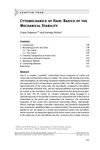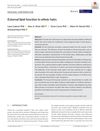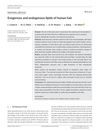Fundamental Studies on the Interaction Between Moisture and Textiles. Part X. Moisture Sorption Properties of Wool and Hair Fibers
January 1989
in “
Sen'i Gakkaishi
”

TLDR Wool and hair fibers absorb moisture similarly due to their keratin structure, with the amount of non-crystalline areas affecting the moisture uptake.
The 1989 study examined the moisture sorption properties of 15 types of wool and hair fibers from various animals at 30°C, using the Brunauer, Emmett, and Teller (B.E.T.) model to analyze the data. The B.E.T. parameters (C, vm, and nmax) were found to be similar across the fibers, indicating a strong influence of the keratin protein composition and supermolecular structures on moisture interaction. The study revealed a linear relationship between the maximum volume of adsorbed moisture in a monolayer (vm) and the degree of noncrystallinity for wool fibers, but deviations for fibers with medulla structures. The sorbed moisture was determined to be in a highly ordered state, especially near dry conditions, and this order was maintained even at saturation. The study also measured the differential heat of moisture sorption and excess energy, further supporting the ordered state of sorbed water.



